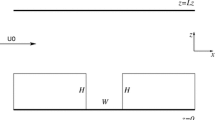Abstract
The transfer processes within and above a simulated urban street canyon were investigated in a generic manner. Computational fluid dynamics (CFD) was used to aid understanding and to produce some simple operational parameterisations. In this study we addressed specifically the commonly met situation where buoyancy effects arising from elevated surface temperatures are not important, i.e. when mechanical forces outweigh buoyancy forces. In a geophysical context this requires that some suitably defined Richardson number is small. From an engineering perspective this is interpreted as the important case when heat transfer within and above urban street canyons is by forced convection. Surprisingly, this particular scenario (for which the heat transfer coefficient between buildings and the flow is largest), has been less well studied than the situation where buoyancy effects are important. The CFD technique was compared against wind-tunnel experiments to provide model evaluation. The height-to-width ratio of the canyon was varied through the range 0.5–5 and the flow was normal to the canyon axis. By setting the canyon’s facets to have the same or different temperatures or to have a partial temperature distribution, simulations were carried out to investigate: (a) the influence of geometry on the flow and mixing within the canyon and (b) the exchange processes within the canyon and across the canyon top interface. Results showed that the vortex-type circulation and turbulence developed within the canyon produced a temperature distribution that was, essentially, spatially uniform (apart from a relatively thin near-wall thermal boundary layer) This allowed the temperatures within the street canyon to be specified by just one value T can , the canyon temperature. The variation of T can with wind speed, surface temperatures and geometry was extensively studied. Finally, the exchange velocity u E across the interface between the canyon and the flow above was calculated based on a heat flux balance within the canyon and between the canyon and the flow above. Results showed that u E was approximately 1% of a characteristic wind velocity above the street canyon. The problem of radiative exchange is not addressed but it can, of course, be introduced analytically, or computationally, when necessary.
Similar content being viewed by others
References
Barlow JF, Belcher SE (2002) A wind tunnel model for quantifying fluxes in the urban boundary layer. Boundary-Layer Meteorol 104:131–150
Barlow JF, Harman IN, Belcher SE (2004) Scalar fluxes from urban street canyon. Part I: laboratory simulation. Boundary-Layer Meteorol 113:369–385
Bentham T, Britter RE (2003) Spatially averaged flow within obstacle arrays. Atmos Environ 37:2037–2043
Bohnenstengel S, Schlunzen KH, Grawe D (2004) Influence of thermal effects on street canyon circulations. Meteorol Zeit 13:381–386
Fluent Manual (2003) Fluent Inc. Chapter 6, pp 14–16, pp 74–80; Chapter 28, pp 7–9
Harman IN, Barlow JF, Belcher SE (2004) Scalar fluxes from urban street canyons. Part II: model. Boundary-Layer Meteorol 113:47–68
Hamlyn D, Britter RE (2005) A numerical study of the flow field and exchange processes within a canopy of urban-type roughness. Atmos Environ 39:3243–3254
Idczak M, Mestayer P, Rosant J-M, Sini J-F, Violeau M (2006) Micro-meteorological measurements in a street canyon during the joint ATREUS-PICADA experiment, Boundary-Layer Meteorol, to appear (DOI 10.1007/s10546-006-9095-z)
Kastner-Klein P, Rotach MW (2004) Mean flow and turbulence characteristics in an urban roughness sublayer. Boundary-Layer Meteorol 111:55–84
Kim J-J, Baik J-J (2001) Urban street-canyon with bottom heating. Atmos Environ 35:3395–3404
Kim J-J, Baik J-J (2004) A numerical study of the effects of ambient wind direction on flow and dispersion in urban street canyons using the RNG k-ɛ turbulence model. Atmos Environ 38:3039–3048
Kovar-Panskus A, Moulinneuf L, Savory E, Abdelqari A, Sini J-F, Rosant J-M, Robins A, Toy N (2002) A wind tunnel investigation of the influences of solar-induced wall-heating on the flow regime within a simulated urban street canyon. Water Air Soil Pollut 2:555–571
Louka P, Vachon G, Sini J-F, Mestayer PG, Rosant J-M (2002) Thermal effects on the airflow in a street canyon – Nantes ’99 experimental results and model simulations. Water Air Soil Pollut 14:351–364
Oke TR (1988) Street design and urban canopy layer climate. Energy Build 11:103–113
Richards PJ, Hoxey RP (1993) Appropriate boundary conditions for computational wind engineering models using the k-ɛ turbulent model. J Wind Eng Ind Aerodynamics 46–47:145–153
Rowley FB, Algren AB, Blackshaw JL (1930) Surface conductances as affected by air velocity, temperature and character of surface. ASHRAE Trans 38:33–46
Sini J-F, Anquetin S, Mestayer PG (1996) Pollutant dispersion and thermal effects in urban street canyons. Atmos Environ 30:2659–2677
Author information
Authors and Affiliations
Corresponding author
Rights and permissions
About this article
Cite this article
Solazzo, E., Britter, R.E. Transfer processes in a simulated urban street canyon. Boundary-Layer Meteorol 124, 43–60 (2007). https://doi.org/10.1007/s10546-007-9176-7
Received:
Accepted:
Published:
Issue Date:
DOI: https://doi.org/10.1007/s10546-007-9176-7




